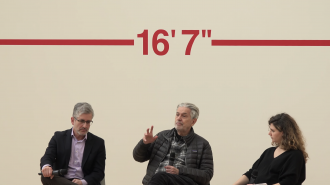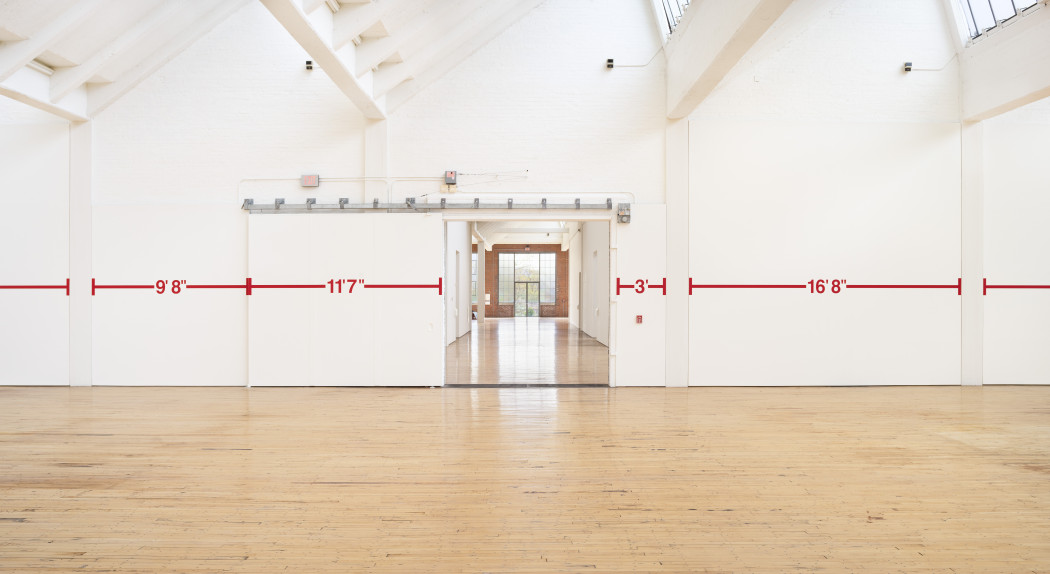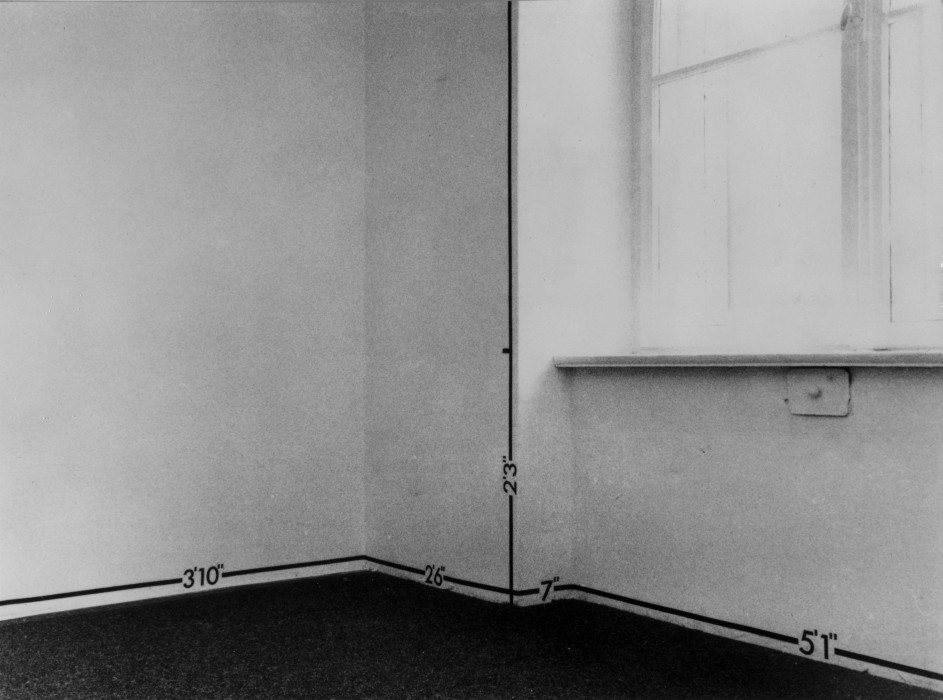Mel Bochner
November 9, 2019–April 4, 2021, Dia Beacon
Overview
On the occasion of the 50th anniversary of Mel Bochner’s first Measurement room, Dia has commissioned the artist to realize a new, large-scale work from his Measurement series at Dia Beacon. Regarded as one of the leading American Conceptual and Postminimal artists in the 1960s and 1970s, Bochner pioneered the play between the characteristics of numerical values, space, and language in his work.
In May 1969 Bochner realized the first works in his ongoing Measurement series, using black tape to draw simple, linear segments across the surfaces of Dia cofounder Heiner Friedrich’s Munich gallery. Punctuating these lines were numbers that corresponded to the length of the measured surface: the width of a window bay, the height of a doorframe, and so on. In this work, as in subsequent iterations of this series, Bochner used lines to wrap around the architectural envelope of the gallery in a systematic evaluation of its spatial parameters and the perceptual experience that unfolds within it. At Dia Beacon, red tape maps the various surfaces of one of the museum’s largest galleries, running horizontally across walls at a height corresponding to the artist’s eye level.
Mel Bochner is made possible by generous support from the Ampersand Foundation. Additional support provided by Jill and Peter Kraus, Simon Lee, and Susan and Larry Marx. Support for the publication is provided by Lisa and Tom Blumenthal; Peter Freeman, Inc.; Evelyn and David Lasry/Two Palms, NY; and Marc Selwyn Fine Art.
Mel Bochner installed his first Measurement: Room at Galerie Heiner Friedrich in Munich, Germany, in May 1969. The work was produced as part of Measurements, a solo exhibition that explored the relationship between the numerical systems that are used to rationalize the built environment and the actual, perceptually contingent experiences that we have of space. As the artist recently explained, “What I realized I needed to do was expose the hidden regime of architecture, to make it reveal itself.” The work transformed the gallery into a three-dimensional blueprint—a projection of spatial volumes—that each viewer had to reconcile with the actual physical structures enfolding them. Standing before a window marked seven feet high, the adjacent five-foot-wide doorframe was obscured; looking at a wall ten feet and ten inches long, the windows receded to the background. The room revealed itself through movement, but only relative to the viewer’s own body. The 1969 work presented an index of architectural features that fractured the viewer’s perception of the exhibition space as a whole. Dispersing the art object throughout the gallery by surrounding the viewer with notations, the Measurement: Room transposed the work’s center onto the mobile visitor.
Several months later, the artist proposed a second project to Friedrich (the eponymous gallerist who would go on to cofound Dia Art Foundation in 1974) called No Vantage Point: Eye Level Cross-Section of a Room. Though it went unrealized, No Vantage Point perceptually bound the walls of Friedrich’s gallery together by tracing a perimeter line around the room. It too untethered the aesthetic experience from any single perspective. The red line was evenly marked no matter which way the viewer looked. “For me,” Bochner has noted, “an essential part of this work’s meaning is the experience of the room’s emptiness.”
Measurement Room: No Vantage Point, commissioned by Dia on the occasion of the fiftieth anniversary of these two projects, brings elements of each together in the largest installation of the Measurement series to date. Consisting of a thick red line that is broken up by numerical intervals, the work circumscribes one of Dia:Beacon’s central galleries and measures its walls. At first glance, the museum’s repetitious bays appear uniformly sized; but as the viewer moves through the space, the subtle variances between them—often a matter of inches, which would otherwise be invisible to the naked eye—are exposed. While the walls fluctuate, the line runs evenly over them at six feet (Bochner’s own eye level, or what he calls his “horizon line”) and establishes a kind of control against which visitors can measure their experience of this space. In this sense, Bochner positions the viewers themselves as their own measuring instruments.
Measurement Room: No Vantage Point addresses the friction produced between the body as a measure of space and the other metrics of identity that we use today. The Measurement series was conceived at a moment when perceptual processes came under investigation by a range of artists who were concerned with the administration of modern space and the ways in which mapping and communication technologies subordinate the experience of real space. As our social relations are increasingly mediated by apps and avatars, the kind of embodied knowledge that Bochner cultivates in viewers is a reminder that in our physicality we are also each a measure of the physical world.
—Alexis Lowry

Measurement Room: No Vantage Point, 1969/2019
Vinyl on wall
Courtesy the artist and Peter Freeman Gallery, New York
Mel Bochner was born in Pittsburgh in 1940. Bochner received his BFA (1962) and honorary Doctor of Fine Arts (2005) from the School of Art at Carnegie Mellon University, Pittsburgh, where he studied under Douglas Wilson and Wilfred Readio. After completing his BFA, Bochner studied philosophy at Northwestern University, Evanston, Illinois, before moving to New York City in 1964. Bochner’s work has been included in numerous group shows internationally, with notable solo exhibitions at Carnegie Mellon Art Gallery (1985), Sonnabend Gallery, New York (2000), and Whitechapel Gallery, London (2012). Major retrospectives of his work have been held at the Yale University Art Gallery, New Haven, Connecticut (1995), and the National Gallery of Art, Washington, DC (2011). He also participated in the Whitney Biennial (2004) and Documenta (1972), among other international surveys. His work is collected by major institutions including Tate Modern, London, and Museum of Modern Art, New York. He lives and works in New York.
Artist
Mel Bochner
Mel Bochner was born in Pittsburgh in 1940. He lives and works in New York City.
Explore
Mel Bochner in Conversation with Alexis Lowry and James Meyer
Move to Mel Bochner in Conversation with Alexis Lowry and James Meyer page


